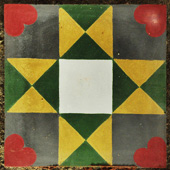Design Resource
Athangudi Tiles - Karaikudi
Making of Decorative Floor Tiles
by
Prof. Bibhudutta Baral, B. Srikanth and Raghavendra Chari K. M.
The tiles are made from the mixture of cement and sand. Sand is filtered to remove impurities from it. Cement and sand and baby jelly is mixed with water and converted into dough. To make the colors for the tiles, artisan mixes measured quantity of color with sand, cement and water turning it into a thin paste. Earlier it was a manual process but now mixing machine machines are used for the same purpose. The machine mixes the materials and converts them into much finer paste. Glass slabs are cleaned and placed as a base for the tile. A metal border frame is placed over the glass slab to form the tile. Inside the border frame, the designed frame locally called as Aass, is placed to make the design. Color solution is poured in different compartment of the frame according to the design. Sometimes the color is poured directly on the glass and the artisan stirs it manually to attain a design. Once the design is made, dry mixture of sand and cement is sprinkled on the colored layer to absorb the moisture and avoid mixing of colors with each other.
The pre-prepared dough is spread on the design with the help of the spade and then leveled. Excess of cement is removed with the help of a blade. The border frame is removed and the tile is kept to dry in room temperature for overnight. Then the dried tiles are soaked in water tank and kept them in for 6 days. Later they are removed from the water tank and kept in sunlight to dry. When dried the glass frame automatically ease out. The glass slab leaves a shine and luster effect on the final product. The production of the tiles is made all throughout the year and it provides livelihood for many people. Both men and women are involved in making of the Athangudi tiles.













